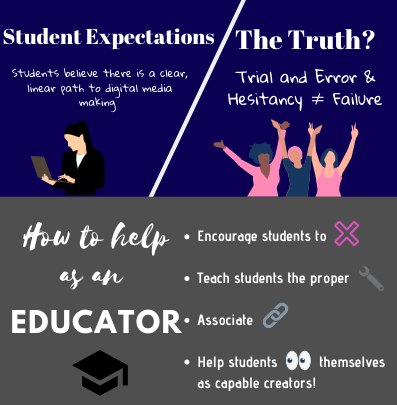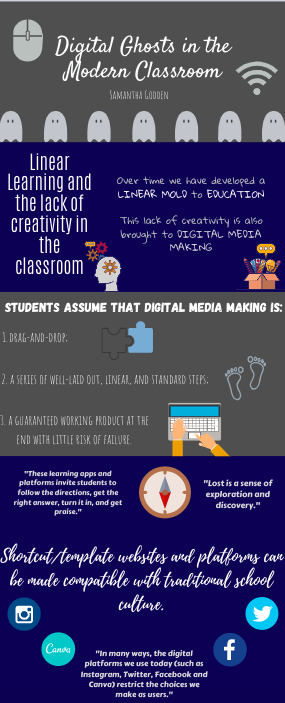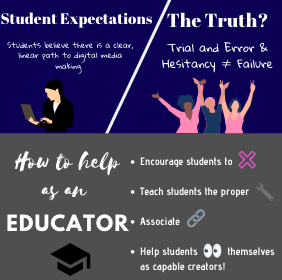For this assignment, I decided to work with Ashley Hinck’s article “Digital Ghosts in the Modern Classroom”. In the article, Hinck criticizes our school system by stating that our education system has developed a linear way of learning. This belief stems from the idea that all students are expected to get the same thing out of lessons, and only create products that they believe the teacher will want to see. We are so comfortable with these methods that we expect this sort of linear, step-by-step method in other aspects of our life, such as in digital media making. These forms of learning can be harmful, as they discourage creativity and difference. We are teaching students to follow a specific set of instructions in order to achieve their goals.
An important aspect of every app/website that promotes digital media making is user friendliness, and therefore most of the widely known platforms are very easy to use and understand. This removes the need for technological knowledge and limits the amount of choices creators have to make their creations unique and different. These websites provide things like drag-and-drop processes, a series of well laid out steps and a guaranteed working product at the end with little risk of failure.
How might we discourage this static view of digital media making? Leave the shortcut/template websites behind! There are many websites that allow users to take a more hands-on approach and that allow the user to develop their computer knowledge, take a shot at coding and truly express their creativity. These websites, while more complicated, show students that there is no linear path to success. It will show students to appreciate tiny victories and will teach them essential skills such as problem-solving and critical thinking.
Students have expectations on what digital media making entails, and when they begin the process of using websites that requires the user to do more complicated things such as coding, they begin to feel discouraged. The linear path to success that they are familiar with is no longer relevant and students start to feel frustrated. They truly believe that because they are experiencing difficulties and must engage in trial and error, that they are failing. This is far from the truth, as hesitancy and trial and error are essential aspects of digital media making.
In order to change the ways students see digital media making, there are a few ways we can help as educators! Firstly, it is important to encourage students to try, fail, and try again! Students believe that failing is something they should always avoid, however this is not the case in digital media making! Failing allows the student to learn from their mistakes and develop necessary knowledge on how they can improve. It is also essential that we teach students the proper tools and language of digital media making. In doing this, we are giving them the necessary vocabulary and resources to troubleshoot any issues they might have, so that they are able to become true digital media makers outside of the classroom. Thirdly, associating their digital media making with other examples of making, troubleshooting and fixing will allow students to recognize that they are capable creators!

For this assignment, I decided to use Canva as I had no previous experience with the website and I thought it would be fun to challenge myself (in the context of this assignment) to create an infographic without using any of the provided templates, in order to insert a bit more creativity. I found it easy to use, and I can recognize how websites such as Canva make it very easy to produce a good looking product with minimal creativity and work. This article has definitely opened up my eyes and will definitely influence the types of digital media making projects I give as an educator.
Here is the full Infographic that is not split up if you would like to see it in your entirety!


